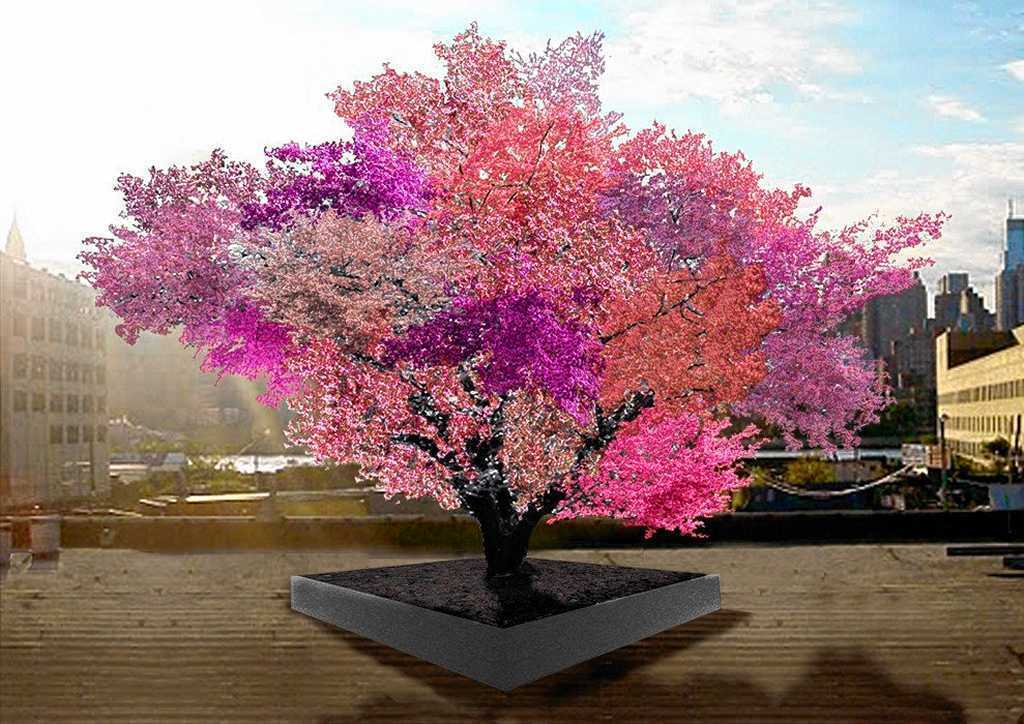Tree of 40 Fruit: Dazzling Franken-Tree Has Roots in Science

An art project featuring a live tree that bears 40 different kinds of fruit is more than just a conversation piece. The so-called "Tree of 40 Fruit" — blossoming in a variety of pretty pink hues when completed — is rooted in science.
The eye-catching artistic rendering of the tree brought worldwide attention to its creator, Sam Van Aken, a professor in the school of art at Syracuse University in New York. And although Van Aken's "Franken-tree" is not common, the processes that hold it together are, according to experts.
"[Van Aken has] taken the idea of a single root stock and a single variety and amplified it to express something creative, and that's the artistic side of it for him," said Greg Peck, an assistant professor of horticulture at Virginia Tech in Blacksburg. [Nature's Giants: Photos of the Tallest Trees on Earth]
The 40 fruit-bearing tree includes only "stone fruits" from the Prunus genus, which all share very similar genetics. The tree looks like any other fruit tree for most of the year until spring, when it pops into pink, white and crimson blooms. In summer, the tree bursts with ripened fruit, including peaches, plums, apricots, nectarines, cherries and almonds.
Grafting
To squeeze all 40 fruit varieties onto one tree, Van Aken is "grafting" budding branches from individual fruit trees onto one, large tree. To do this, he slices a mature, slightly brownish branch with buds from a peach tree, for instance, and inserts the branch into a matching slit in a branch on the Tree of 40 Fruit. Once the two branches connect, he winds tape around their point of contact, allowing the bud to grow into a new branch.
The branches' intimate connection is key, though they can also connect at various parts on the tree, including at the roots. How two types of trees are grafted together can also vary, from using a small incision for "bud grafting" (what Van Aken did) to an amputation-like cut for "whip grafting."
Sign up for the Live Science daily newsletter now
Get the world’s most fascinating discoveries delivered straight to your inbox.
"There are tons of different kinds of grafts, but at the end of the day, what's important in the graft is that the vascular tissue from the two pieces of plant material are connected," Peck said.
Vascular tissue is the pale, soft and slightly spongy material that lies underneath bark. It includes xylem, which shuttles water and nutrients through the branches; phloem, which carries sugars and carbohydrates, and cambium, which divides the xylem and phloem tissues.
Specifically, the two plant materials must connect at the cambium to allow the flow of nutrients and water from one plant to the other, which ensures the survival of the graft, Peck told Live Science.
If two trees grow close enough together, it's possible for them to form a natural graft, as long as the outside bark is worn away and the vascular tissues connect, he added. Root grafting can also happen when two trees' roots connect and exchange nutrients and water, Peck said.
Uniform fruit
Since nature's grafts are unpredictable, people have taken matters into their own hands. Grafting is particularly useful for fruit trees in commercial settings and has been used for centuries. The grafting process ensures that the fruit stays "true to type," Peck said.
"True to type" means that "the Gala apple that you buy at the supermarket is identical to every other Gala apple that you buy," Peck said. As such, a branch from one Gala apple tree is used to make another Gala apple tree, and a branch from the new Gala tree can propagate future generations of Gala trees, Peck said.
Gala apple tree branches are attached to a "root stock" that includes the root system and base of the tree. It is the lowest section of the tree that comes into contact with a graft, Peck said.
For his Tree of 40 Fruit, Van Aken chose a plum tree root stock that was 3 years old and had about 4 or 5 branches when he first started grafting. The plum tree has good structure,” Van Aken said, and is among the most compatible to other stone fruit. It also offers especially sturdy support for all 40 fruit varieties, he added.
A couple varieties of fruit are grafted onto the tree every year, Van Aken told Live Science, and he's nuturing multiple franken-trees. He currently has 16 grafted multi-fruit trees under his care, with the most recent planted this past fall.
Still, producing a tree that bears so many different kinds of fruit is more complicated than simply finding a sturdy root stock. One root stock does not fit all, but it can accommodate multiple fruits of the same genus, said Amaya Atucha, an assistant professor of horticulture at the University of Wisconsin-Madison. For example, orange trees and apple trees can't share a root stock, but peaches and almonds can, Atucha said. [6 Trees That Are Easier to Identify in Fall]
Nurseries often grow root stocks as little trees until they are 1 or 2 years old, then cut their small branches (using whip grafting) and graft a branch of a fruit tree. With this method, root stocks can be bred to be pest-resistant and tolerant to acidity, among other desirable traits, Atucha told Live Science.
Diversified fruit
Grafting can keep the taste and look of fruit uniform, but the technique also allows a variety of fruit to share the same tree.
"Forty [varieties of fruit] is pretty exciting and unique, but it can be done," Peck said. However, not only would it take precision to graft each branch onto the main tree, the tree would require a lot of maintenance. Over time, if the tree grew freely without human care, "one of these or several varieties [of fruit] will be more rigorous than others and probably outcompete their neighbor graft," becoming larger and shading out other grafts, Peck said.
Harvesting the tree will also be a slightly longer process, because the fruits will ripen at different times. For instance, the cherries will need to be picked before the apricots, and the apricots will drop from the tree before the peaches.
Root stocks are also bred for height, so certain breeds can grow into massive trees that are able to support a multitude of fruit, Peck said. Commercial growers, however, rely on grafting to produce true-to-type fruits that grow uniformly, because having trees that are the same size and shape makes for easier harvesting. For that reason, it would be difficult for commercial growers to grow multi-fruit trees, Atucha said.
Still, homeowners, free from commercial constraints, can grow multi-fruit trees, and some already do. "We see it sometimes with apples," Peck said. "People will do this in their backyards with apples and graft different varieties onto one apple tree."
Elizabeth Goldbaum is on Twitter. Follow Live Science @livescience, Facebook & Google+. Original article on Live Science










